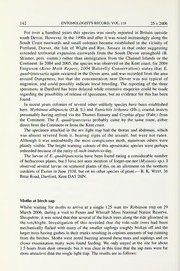
Moths at birch sap PDF
Preview Moths at birch sap
142 ENTOMOLOGIST’SRECORD,VOL. 118 25.V.2006 For over a hundred years this species was rarely reported in Britain outside south Devon. However, in the 1990s and after it was noted increasingly along the South Coast eastwards and small colonies became established in the vicinity of Portland, Dorset, the Isle of Wight and Rye, Sussex in that order suggesting extended territorial expansion eastwards from the South Devon stronghold (B. Skinner, pers. comm.) rather than immigration from the Channel Islands or the Continent. In 2004 and 2005, the species was observed on the Kent coast; for 2004 Ferguson Kent Moth Report, 2004 Butterfly Conservation) states that E. ( quadripunctaria again occurred in the Dover area, and was recorded from the area around Dungeness, but that the concentration near Dover was not typical of migration, and could possibly indicate local breeding. The reporting of the three specimens at Dartford has been delayed while extensive enquiries could be made regarding the possibility ofrelease ofspecimens, but no evidence for this has been found. In recent years colonies of several other unlikely species have been established here. Mythimna albipuncta (D.& S.) and Eumichtis lichenea (Hb.), coastal insects presumably having arrived via the Thames Estuary and Cryphia algae (Fabr.) from the Continent. The E. quadripunctaria probably came by the same route, either directfromtheContinentorfromthe Kentcoast. The specimen attacked in the mv light trap had the thorax and abdomen, which was almost severed from it, bearing signs of the assault, but were not eaten. Although it was undoubtedly the most conspicuous moth, numerous others were plainly visible. The bright warning colours ofthis aposematic species were perhaps unheededbecauseoftherarityofsuchinsectsto-day. The larvae ofE. quadripunctaria have been found eating a considerable number ofherbaceous plants, but I have not seen mention offorget-me-not (Myosotis sp.). I observed several larvae on scattered plants of this on an allotme—nt on the northern outskirts ofExeter in June 1938, but on no other species ofplant. B. K. West, 36 BriarRoad, Dartford, KentDA5 2HN. Mothsatbirchsap Whilst waiting for moths to arrive at a single 125 watt mv Robinson trap on 29 March 2006, during a visit to Fenns and Whixall Moss National Nature Reserve, Shropshire, it was notedthatthat several ofthebirch trees along theride glistened in the torchlight. Investigation of this revealed that the ride-side trees had been mechanically flailed with many of the smaller saplings roughly broken off and the largertrees having gashes in theirtrunks resulting in copious amounts ofsaprunning from the birches. Moths were noted buzzing around these trees and saplings and on closer examination many were found feeding. We only stayed at the site for about 1.5 hours from dusk onwards, but it was clear in this time that the sap runs were far moreattractive thanthe single lighttrap. Theresults are asfollows: NOTES 143 MV Species light Birchsap Semioscopisavellanella 1 Tortricodesalternella 1 Aclerisnotana(notgen.det.) 2 YellowHomedAchylaflavicornis approx. 10 approx.25 MarchMothAlsophilaaescularia 1 OakBeautyBistonstrataria 1 (thoughnotfeeding) PineBeautyPanolisflammea 1 SmallQuakerOrthosiacruda 1 CommonQuakerOrthosiacerasi 2 CloudedDrabOrthosiaincerta 2 Twin-spottedQuakerOrthosiamunda approx. 10 HebrewCharacterOrthosiagothica 3 SatelliteEupsiliatransversa 1 approx.25 ChestnutConsitravaccinii approx.5 It is possibly worth noting that although there were plenty of sallows in the general area, noneappearedtobeinblossomatthetime. A quick look through available literature indicates that this appears to be an infrequently reported observation, although birch sap has long been known as an attractantformoths. J. W. Tutt(1902. Practicalhintsforthefieldlepidopterist2: 18) gives an observation by P. C. Reid who refers to the “common practice to bore holes ....in the trunks ofbirch-trees” in Scotland and in early spring finding species such as the Yellow HomedAchylaflavicornis. Sword-grass Xylena exsoleta and the Red Sword-grass X. vetusta amongst many others at the resultant sap runs, adding that theyfedonthis sap “evenmorefreely than.... insectscometo sugar”. We would like to take this opportunity to thank Dr Joan Daniels (Site Manager, English Nature) for permission to record moths at the site.— Mark Parsons & Kelly Thomas, Butterfly Conservation, Manor Yard, East Lulworth, Wareham, DorsetBH205QP.
